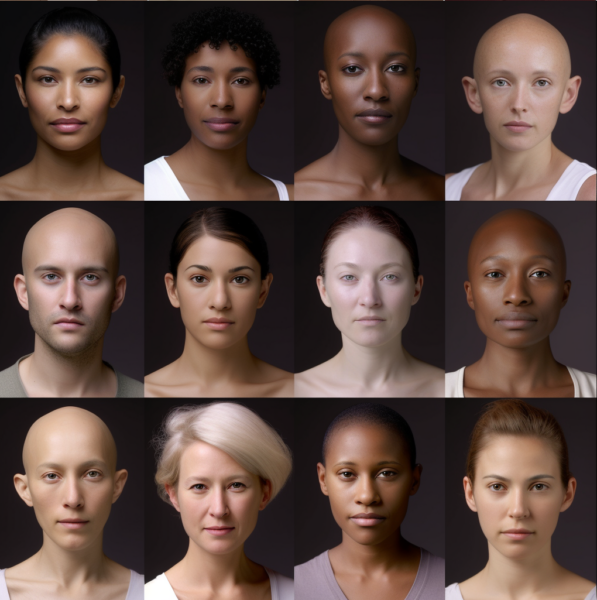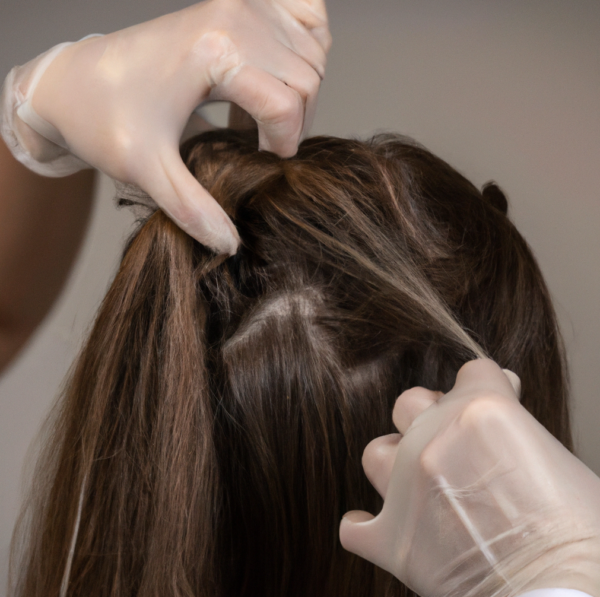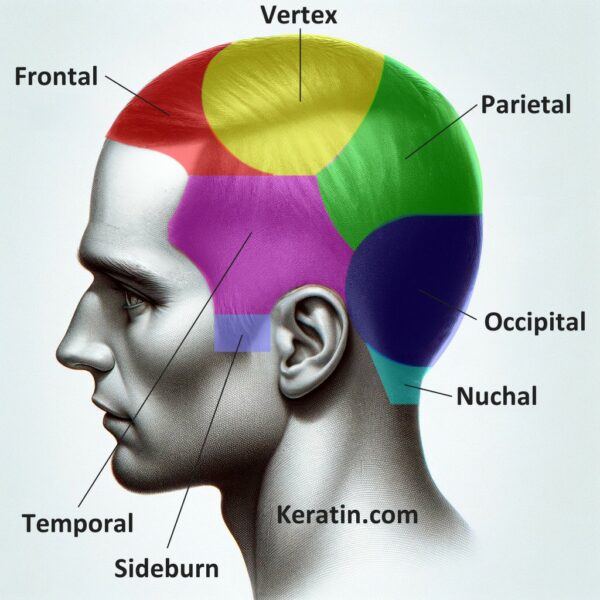Introduction: While scalp hair is first and foremost a marker of personal style, it is also a critical indicator of an individual’s health. Among the various signs that dermatologists and trichologists use to diagnose health issues through hair examination, the “flag sign” is particularly noteworthy. This sign, visible in hair fibers, is characterized by alternating dark and light bands, resembling the pattern of a flag. The presence of the flag sign is not merely a cosmetic concern, but is often indicative of underlying health issues, primarily nutritional deficiencies or systemic illnesses.
Understanding the Flag Sign: The flag sign manifests as distinct bands of different colors along the length of a hair strand. Typically, these bands alternate between the individual’s natural hair color and a lighter shade. The appearance of these bands is usually due to variations in the quality and intensity of pigmentation of the hair as it grows.
As the melanocyte cells that make the pigment to be incorporated into the hair fiber as it grows, the cells’ activity can be adversely affected by what’s happening locally in the skin and elsewhere in the body. As time goes on, these adverse influences may increase and decrease in intensity and the melanocyte cells’ activity may also wax and wane in response. The development of the flag sign is a gradual process, reflecting changes in the body’s health status over time. As scalp hair typically only grows at around 0.3mm per day (or slower in people with severe illness), it can take some period of time before the hair flag sign becomes fully apparent.
A more subtle version of the flag sign can sometimes be seen in gray hair. It can be hard to see as the flag sign in grey hair is not due to changes in pigmentation, but rather it is caused by changes in the production of keratin. The quality and density of keratin incorporated into hair fiber can change in response to systemic illness. These changes can subtly affect the ability of the hair to reflect light. As a result, the flag sign can occur in non-pigmented hair due to alternating bands of lighter and darker “grey” as a result of the differences in the ability to reflect light. Interestingly, the flag sign can also be seen in finger and toe nails as nails are made from the same material has hair fiber.
Causes of the Flag Sign:
Nutritional Deficiencies : The most common cause of the flag sign in hair fibers is nutritional deficiency. Essential nutrients including proteins, vitamins, and minerals play a pivotal role in maintaining the health and pigmentation of hair. Deficiencies in these nutrients, particularly biotin, zinc, and iron, can lead to the flag sign. For instance, periods of malnutrition or strict dieting can correlate with lighter bands of color in hair, indicating reduced nutrient availability during those times.Systemic Illnesses : Certain systemic illnesses can also lead to the flag sign. These include conditions that affect the body’s ability to absorb nutrients or that lead to increased nutrient requirements. Chronic illnesses such as gastrointestinal diseases, which impair nutrient absorption, or conditions like cancer, which increase the body’s nutritional needs, can manifest as the flag sign in hair. As the illness is systemic, the flag sign can develop in all scalp hair fibers – though there is usually some variation in degrees of effect across the scalp.Hair and Scalp Conditions : Diseases that specifically affect the hair and scalp can also cause the flag sign. Conditions like alopecia areata or fungal infections can disrupt the normal growth and pigmentation of hair, leading to the appearance of the flag sign. Usually in these cases, if the flag sign does occur, it is often limited to just a small area of the scalp where the alopecia areata is active or the fungal infection is present.Medications, Treatments, and Poisons : Some medications and medical treatments, particularly chemotherapy, can affect hair pigmentation and texture, resulting in the flag sign. These treatments can cause interruptions in the hair growth cycle, leading to variations in the hair’s color and structure as it grows. Similarly, the flag sign has been observed in the hair of people exposed to toxins. As such, it is of interest to police forensics and pathologists as it is sometimes identified in people who have been slowly poisoned – particularly with thallium acetate (rat poison). The loss of pigment in a portion of the hair fiber indicates temporary exposure to the poison equivalent to the length of depigmented hair produced.Psychological Stress : Psychological stress is another factor that can influence hair health. Severe stress can disrupt the normal hair growth cycle, potentially leading to the flag sign. It’s a fairly rare feature, but it can occur in people exposed to chronic stress. This disruption is often temporary, and normal hair growth and hair pigmentation resumes once the stress is alleviated.Diagnosis and Analysis: Diagnosing the flag sign involves a thorough examination of the hair and scalp. Trichologists or dermatologists typically use a dermatoscope, a specialized tool that magnifies the hair and scalp, to observe the pattern and extent of the flag sign. In addition to a physical examination, medical professionals may also inquire about the patient’s dietary habits, medical history, and any recent illnesses or stressors. In some cases, blood tests may be conducted to identify nutritional deficiencies, or underlying health conditions.
Treatment and Management: The treatment of the flag sign in hair fibers largely depends on its underlying cause. For nutritional deficiencies, dietary modifications and supplementation are often the approach taken. Incorporating a balanced diet rich in proteins, vitamins, and minerals can gradually restore hair health. If a systemic illness is the cause, treating the underlying condition is crucial. For hair and scalp conditions, specific treatments like antifungal medications or therapies for alopecia areata may be necessary. In cases where psychological stress is a factor, stress management techniques and counseling may be beneficial.
Conclusion: The flag sign in hair fibers is a distinctive marker that serves as a window into an individual’s overall health. It is a visual reminder of the intricate connection between our dietary habits, health status, and external appearance. Recognizing and understanding the flag sign can lead to early interventions and treatment of the underlying causes, ultimately contributing to better health and well-being. As research in the field of hair and skin disease continues to evolve, the importance of such external indicators in diagnosing and managing health conditions becomes increasingly evident.
Bibliography
11711645 {11711645:CDZHI6CT},{11711645:SNC2VMTA},{11711645:B7K3UDPM},{11711645:E6234CEH},{11711645:T8RD9TB3},{11711645:2ZZZDI6D},{11711645:2IMEFGU2},{11711645:3PKRMMD4},{11711645:8KNVEAJE},{11711645:UNA2AXNJ},{11711645:UX8G88UQ},{11711645:5CDN2I6F},{11711645:WSP7GZ6D},{11711645:4TGQQTNB},{11711645:HINRTHU5} vancouver 50 date asc 1087 https://www.keratin.com/wp-content/plugins/zotpress/ %7B%22status%22%3A%22success%22%2C%22updateneeded%22%3Afalse%2C%22instance%22%3A%22zotpress-490ad389a2d6b1a64c5e8aa31d9084af%22%2C%22meta%22%3A%7B%22request_last%22%3A0%2C%22request_next%22%3A0%2C%22used_cache%22%3Atrue%7D%2C%22data%22%3A%5B%7B%22key%22%3A%22HINRTHU5%22%2C%22library%22%3A%7B%22id%22%3A11711645%7D%2C%22meta%22%3A%7B%22creatorSummary%22%3A%22Bradfield%22%2C%22parsedDate%22%3A%221974-02%22%2C%22numChildren%22%3A0%7D%2C%22bib%22%3A%22%3Cdiv%20class%3D%5C%22csl-bib-body%5C%22%20style%3D%5C%22line-height%3A%201.35%3B%20%5C%22%3E%5Cn%20%20%3Cdiv%20class%3D%5C%22csl-entry%5C%22%20style%3D%5C%22clear%3A%20left%3B%20%5C%22%3E%5Cn%20%20%20%20%3Cdiv%20class%3D%5C%22csl-left-margin%5C%22%20style%3D%5C%22float%3A%20left%3B%20padding-right%3A%200.5em%3B%20text-align%3A%20right%3B%20width%3A%201em%3B%5C%22%3E1.%3C%5C%2Fdiv%3E%3Cdiv%20class%3D%5C%22csl-right-inline%5C%22%20style%3D%5C%22margin%3A%200%20.4em%200%201.5em%3B%5C%22%3EBradfield%20RB.%20Hair%20tissue%20as%20a%20medium%20for%20the%20differential%20diagnosis%20of%20protein-calorie%20malnutrition%3A%20a%20commentary.%20J%20Pediatr.%201974%20Feb%3B84%282%29%3A294%26%23x2013%3B6.%3C%5C%2Fdiv%3E%5Cn%20%20%20%3C%5C%2Fdiv%3E%5Cn%3C%5C%2Fdiv%3E%22%2C%22data%22%3A%7B%22itemType%22%3A%22journalArticle%22%2C%22title%22%3A%22Hair%20tissue%20as%20a%20medium%20for%20the%20differential%20diagnosis%20of%20protein-calorie%20malnutrition%3A%20a%20commentary%22%2C%22creators%22%3A%5B%7B%22creatorType%22%3A%22author%22%2C%22firstName%22%3A%22R.%20B.%22%2C%22lastName%22%3A%22Bradfield%22%7D%5D%2C%22abstractNote%22%3A%22%22%2C%22date%22%3A%221974-02%22%2C%22language%22%3A%22eng%22%2C%22DOI%22%3A%2210.1016%5C%2Fs0022-3476%2874%2980625-6%22%2C%22ISSN%22%3A%220022-3476%22%2C%22url%22%3A%22%22%2C%22collections%22%3A%5B%22KP7FJDKM%22%5D%2C%22dateModified%22%3A%222024-01-23T20%3A35%3A01Z%22%7D%7D%2C%7B%22key%22%3A%228KNVEAJE%22%2C%22library%22%3A%7B%22id%22%3A11711645%7D%2C%22meta%22%3A%7B%22creatorSummary%22%3A%22MacNamara%20et%20al.%22%2C%22parsedDate%22%3A%221981-08%22%2C%22numChildren%22%3A0%7D%2C%22bib%22%3A%22%3Cdiv%20class%3D%5C%22csl-bib-body%5C%22%20style%3D%5C%22line-height%3A%201.35%3B%20%5C%22%3E%5Cn%20%20%3Cdiv%20class%3D%5C%22csl-entry%5C%22%20style%3D%5C%22clear%3A%20left%3B%20%5C%22%3E%5Cn%20%20%20%20%3Cdiv%20class%3D%5C%22csl-left-margin%5C%22%20style%3D%5C%22float%3A%20left%3B%20padding-right%3A%200.5em%3B%20text-align%3A%20right%3B%20width%3A%201em%3B%5C%22%3E1.%3C%5C%2Fdiv%3E%3Cdiv%20class%3D%5C%22csl-right-inline%5C%22%20style%3D%5C%22margin%3A%200%20.4em%200%201.5em%3B%5C%22%3EMacNamara%20H%2C%20Paver%20K%2C%20Chapman%20RE.%20The%20flag%20sign%20in%20the%20hair%20of%20an%20alcoholic.%20Australas%20J%20Dermatol.%201981%20Aug%3B22%282%29%3A68%26%23x2013%3B70.%3C%5C%2Fdiv%3E%5Cn%20%20%20%3C%5C%2Fdiv%3E%5Cn%3C%5C%2Fdiv%3E%22%2C%22data%22%3A%7B%22itemType%22%3A%22journalArticle%22%2C%22title%22%3A%22The%20flag%20sign%20in%20the%20hair%20of%20an%20alcoholic%22%2C%22creators%22%3A%5B%7B%22creatorType%22%3A%22author%22%2C%22firstName%22%3A%22H.%22%2C%22lastName%22%3A%22MacNamara%22%7D%2C%7B%22creatorType%22%3A%22author%22%2C%22firstName%22%3A%22K.%22%2C%22lastName%22%3A%22Paver%22%7D%2C%7B%22creatorType%22%3A%22author%22%2C%22firstName%22%3A%22R.%20E.%22%2C%22lastName%22%3A%22Chapman%22%7D%5D%2C%22abstractNote%22%3A%22%22%2C%22date%22%3A%221981-08%22%2C%22language%22%3A%22eng%22%2C%22DOI%22%3A%2210.1111%5C%2Fj.1440-0960.1981.tb00787.x%22%2C%22ISSN%22%3A%220004-8380%22%2C%22url%22%3A%22%22%2C%22collections%22%3A%5B%22KP7FJDKM%22%5D%2C%22dateModified%22%3A%222024-01-23T17%3A35%3A10Z%22%7D%7D%2C%7B%22key%22%3A%224TGQQTNB%22%2C%22library%22%3A%7B%22id%22%3A11711645%7D%2C%22meta%22%3A%7B%22creatorSummary%22%3A%22Wheeland%20et%20al.%22%2C%22parsedDate%22%3A%221983-04-15%22%2C%22numChildren%22%3A0%7D%2C%22bib%22%3A%22%3Cdiv%20class%3D%5C%22csl-bib-body%5C%22%20style%3D%5C%22line-height%3A%201.35%3B%20%5C%22%3E%5Cn%20%20%3Cdiv%20class%3D%5C%22csl-entry%5C%22%20style%3D%5C%22clear%3A%20left%3B%20%5C%22%3E%5Cn%20%20%20%20%3Cdiv%20class%3D%5C%22csl-left-margin%5C%22%20style%3D%5C%22float%3A%20left%3B%20padding-right%3A%200.5em%3B%20text-align%3A%20right%3B%20width%3A%201em%3B%5C%22%3E1.%3C%5C%2Fdiv%3E%3Cdiv%20class%3D%5C%22csl-right-inline%5C%22%20style%3D%5C%22margin%3A%200%20.4em%200%201.5em%3B%5C%22%3EWheeland%20RG%2C%20Burgdorf%20WH%2C%20Humphrey%20GB.%20The%20flag%20sign%20of%20chemotherapy.%20Cancer.%201983%20Apr%2015%3B51%288%29%3A1356%26%23x2013%3B8.%3C%5C%2Fdiv%3E%5Cn%20%20%20%3C%5C%2Fdiv%3E%5Cn%3C%5C%2Fdiv%3E%22%2C%22data%22%3A%7B%22itemType%22%3A%22journalArticle%22%2C%22title%22%3A%22The%20flag%20sign%20of%20chemotherapy%22%2C%22creators%22%3A%5B%7B%22creatorType%22%3A%22author%22%2C%22firstName%22%3A%22R.%20G.%22%2C%22lastName%22%3A%22Wheeland%22%7D%2C%7B%22creatorType%22%3A%22author%22%2C%22firstName%22%3A%22W.%20H.%22%2C%22lastName%22%3A%22Burgdorf%22%7D%2C%7B%22creatorType%22%3A%22author%22%2C%22firstName%22%3A%22G.%20B.%22%2C%22lastName%22%3A%22Humphrey%22%7D%5D%2C%22abstractNote%22%3A%22A%20case%20of%20horizontal%20pigmented%20bands%20developing%20within%20the%20hair%20of%20a%20patient%20on%20intermittent%20high-dose%20methotrexate%20chemotherapy%20is%20presented.%22%2C%22date%22%3A%221983-04-15%22%2C%22language%22%3A%22eng%22%2C%22DOI%22%3A%2210.1002%5C%2F1097-0142%2819830415%2951%3A8%3C1356%3A%3Aaid-cncr2820510806%3E3.0.co%3B2-6%22%2C%22ISSN%22%3A%220008-543X%22%2C%22url%22%3A%22%22%2C%22collections%22%3A%5B%22KP7FJDKM%22%5D%2C%22dateModified%22%3A%222024-01-23T17%3A34%3A57Z%22%7D%7D%2C%7B%22key%22%3A%222IMEFGU2%22%2C%22library%22%3A%7B%22id%22%3A11711645%7D%2C%22meta%22%3A%7B%22creatorSummary%22%3A%22Kijewski%22%2C%22parsedDate%22%3A%221984%22%2C%22numChildren%22%3A0%7D%2C%22bib%22%3A%22%3Cdiv%20class%3D%5C%22csl-bib-body%5C%22%20style%3D%5C%22line-height%3A%201.35%3B%20%5C%22%3E%5Cn%20%20%3Cdiv%20class%3D%5C%22csl-entry%5C%22%20style%3D%5C%22clear%3A%20left%3B%20%5C%22%3E%5Cn%20%20%20%20%3Cdiv%20class%3D%5C%22csl-left-margin%5C%22%20style%3D%5C%22float%3A%20left%3B%20padding-right%3A%200.5em%3B%20text-align%3A%20right%3B%20width%3A%201em%3B%5C%22%3E1.%3C%5C%2Fdiv%3E%3Cdiv%20class%3D%5C%22csl-right-inline%5C%22%20style%3D%5C%22margin%3A%200%20.4em%200%201.5em%3B%5C%22%3EKijewski%20H.%20%5BNature%20of%20the%20black%20zones%20in%20hair%20following%20ingestion%20of%20thallium%5D.%20Arch%20Kriminol.%201984%3B173%281%26%23x2013%3B2%29%3A36%26%23x2013%3B44.%3C%5C%2Fdiv%3E%5Cn%20%20%20%3C%5C%2Fdiv%3E%5Cn%3C%5C%2Fdiv%3E%22%2C%22data%22%3A%7B%22itemType%22%3A%22journalArticle%22%2C%22title%22%3A%22%5BNature%20of%20the%20black%20zones%20in%20hair%20following%20ingestion%20of%20thallium%5D%22%2C%22creators%22%3A%5B%7B%22creatorType%22%3A%22author%22%2C%22firstName%22%3A%22H.%22%2C%22lastName%22%3A%22Kijewski%22%7D%5D%2C%22abstractNote%22%3A%22A%20total%20of%20510%20hairs%20with%20Widy%27s%20zones%20from%206%20cases%20of%20poisoning%20were%20microscopically%20studied%2C%20both%20with%20light%20from%20above%20and%20from%20below.%20In%20every%20instance%20when%20the%20light%20came%20from%20below%20the%20zones%20appeared%20lighter%20in%20colour%20when%20pressure%20was%20applied.%20This%20lighting-up%20in%20color%20was%20reversible.%20This%20effect%20is%20incompatible%20with%20the%20opinion%2C%20still%20prevalent%20today%2C%20that%20the%20zones%20may%20be%20explained%20by%20hyperpigmentation.%20Quite%20frequently%20the%20zones%20became%20lighter%20during%20a%20prolonged%20exposure%20to%20water%20while%20simultaneously%20gas%20bubbles%20developed.%20However%2C%20even%20after%20extensive%20exposure%20to%20thioglycolic%20acid%20the%20zones%20did%20not%20disappear%20entirely%20in%20all%20cases.%20We%20explain%20these%20phenomena%20with%20the%20total%20reflection%20of%20the%20light%20at%20numerous%20bordering%20surface%20of%20substances%20with%20differing%20indices%20of%20fraction.%20We%20measured%20the%20thallium%20concentration%20in%20the%20urine%20and%20in%20the%20hair%20during%20the%20time%20interval%20between%20two%20thallium%20poisonings%20with%20the%20result%20that%20in%20those%20parts%20of%20the%20hair%20which%20had%20grown%20during%20a%20period%20when%20no%20thallium%20level%20was%20measured%20in%20the%20urine%20we%20found%20discernibly%20to%20strongly%20increased%20thallium%20concentrations.%20The%20results%20of%20our%20study%20indicate%20that%2C%20considering%20the%20most%20recent%20knowledge%2C%20proof%20of%20multiple%20thallium%20poisoning%20ought%20not%20to%20be%20attempted%20by%20means%20of%20fractional%20chemical%20investigation%20of%20the%20hair%20alone.%22%2C%22date%22%3A%221984%22%2C%22language%22%3A%22ger%22%2C%22DOI%22%3A%22%22%2C%22ISSN%22%3A%220003-9225%22%2C%22url%22%3A%22%22%2C%22collections%22%3A%5B%22KP7FJDKM%22%5D%2C%22dateModified%22%3A%222024-01-23T17%3A37%3A11Z%22%7D%7D%2C%7B%22key%22%3A%225CDN2I6F%22%2C%22library%22%3A%7B%22id%22%3A11711645%7D%2C%22meta%22%3A%7B%22creatorSummary%22%3A%22Shulman%20et%20al.%22%2C%22parsedDate%22%3A%221986-11%22%2C%22numChildren%22%3A0%7D%2C%22bib%22%3A%22%3Cdiv%20class%3D%5C%22csl-bib-body%5C%22%20style%3D%5C%22line-height%3A%201.35%3B%20%5C%22%3E%5Cn%20%20%3Cdiv%20class%3D%5C%22csl-entry%5C%22%20style%3D%5C%22clear%3A%20left%3B%20%5C%22%3E%5Cn%20%20%20%20%3Cdiv%20class%3D%5C%22csl-left-margin%5C%22%20style%3D%5C%22float%3A%20left%3B%20padding-right%3A%200.5em%3B%20text-align%3A%20right%3B%20width%3A%201em%3B%5C%22%3E1.%3C%5C%2Fdiv%3E%3Cdiv%20class%3D%5C%22csl-right-inline%5C%22%20style%3D%5C%22margin%3A%200%20.4em%200%201.5em%3B%5C%22%3EShulman%20RJ%2C%20DeStefano-Laine%20L%2C%20Petitt%20R%2C%20Rahman%20S%2C%20Reed%20T.%20Protein%20deficiency%20in%20premature%20infants%20receiving%20parenteral%20nutrition.%20Am%20J%20Clin%20Nutr.%201986%20Nov%3B44%285%29%3A610%26%23x2013%3B3.%3C%5C%2Fdiv%3E%5Cn%20%20%20%3C%5C%2Fdiv%3E%5Cn%3C%5C%2Fdiv%3E%22%2C%22data%22%3A%7B%22itemType%22%3A%22journalArticle%22%2C%22title%22%3A%22Protein%20deficiency%20in%20premature%20infants%20receiving%20parenteral%20nutrition%22%2C%22creators%22%3A%5B%7B%22creatorType%22%3A%22author%22%2C%22firstName%22%3A%22R.%20J.%22%2C%22lastName%22%3A%22Shulman%22%7D%2C%7B%22creatorType%22%3A%22author%22%2C%22firstName%22%3A%22L.%22%2C%22lastName%22%3A%22DeStefano-Laine%22%7D%2C%7B%22creatorType%22%3A%22author%22%2C%22firstName%22%3A%22R.%22%2C%22lastName%22%3A%22Petitt%22%7D%2C%7B%22creatorType%22%3A%22author%22%2C%22firstName%22%3A%22S.%22%2C%22lastName%22%3A%22Rahman%22%7D%2C%7B%22creatorType%22%3A%22author%22%2C%22firstName%22%3A%22T.%22%2C%22lastName%22%3A%22Reed%22%7D%5D%2C%22abstractNote%22%3A%22A%20classical%20finding%20of%20protein%20deficiency%20is%20hair%20depigmentation%2C%20or%20the%20flag%20sign.%20To%20determine%20the%20clinical%20conditions%20that%20predispose%20ill%20premature%20infants%20to%20the%20development%20of%20protein%20deficiency%2C%20we%20compared%20the%20clinical%20courses%20and%20nutritional%20histories%20of%20premature%20infants%20receiving%20parenteral%20nutrition%20who%20developed%20the%20flag%20sign%20%28group%20F%29%2C%20with%20those%20of%20a%20matched%20control%20group%20%28Group%20C%29.%20Occurrences%20of%20necrotizing%20enterocolitis%20%28NEC%29%20and%20consequent%20surgery%20were%20significantly%20higher%20in%20group%20F%20than%20in%20group%20C%20%28p%20less%20than%200.002%20and%20p%20less%20than%200.005%2C%20respectively%29.%20No%20differences%20were%20found%20in%20the%20mean%20%28%2B%5C%2F-%20SD%29%20administration%20of%20amino%20acids%20%28group%20F%2C%202.5%20%2B%5C%2F-%200.2%20g%20X%20kg%20X%20day%20vs%20group%20C%2C%202.4%20%2B%5C%2F-%200.4%29%20and%20total%20energy%20%2883.4%20%2B%5C%2F-%2013.4%20kcal%20X%20kg%20X%20day%20vs%2083.6%20%2B%5C%2F-%2011.1%2C%20respectively%29.%20Mean%20serum%20albumin%20levels%20%282.6%20%2B%5C%2F-%200.4%20g%5C%2FdL%20vs%202.6%20%2B%5C%2F-%200.5%2C%20respectively%29%20also%20were%20similar.%20Because%20infants%20in%20both%20groups%20received%20recommended%20amounts%20of%20protein%2C%20results%20suggest%20that%20infants%20who%20have%20NEC%2C%20and%20surgery%20as%20a%20consequence%20of%20NEC%2C%20require%20more%20protein%20than%20is%20presently%20recommended.%22%2C%22date%22%3A%221986-11%22%2C%22language%22%3A%22eng%22%2C%22DOI%22%3A%2210.1093%5C%2Fajcn%5C%2F44.5.610%22%2C%22ISSN%22%3A%220002-9165%22%2C%22url%22%3A%22%22%2C%22collections%22%3A%5B%22KP7FJDKM%22%5D%2C%22dateModified%22%3A%222024-01-23T17%3A42%3A04Z%22%7D%7D%2C%7B%22key%22%3A%22SNC2VMTA%22%2C%22library%22%3A%7B%22id%22%3A11711645%7D%2C%22meta%22%3A%7B%22creatorSummary%22%3A%22Cline%22%2C%22parsedDate%22%3A%221988-04%22%2C%22numChildren%22%3A0%7D%2C%22bib%22%3A%22%3Cdiv%20class%3D%5C%22csl-bib-body%5C%22%20style%3D%5C%22line-height%3A%201.35%3B%20%5C%22%3E%5Cn%20%20%3Cdiv%20class%3D%5C%22csl-entry%5C%22%20style%3D%5C%22clear%3A%20left%3B%20%5C%22%3E%5Cn%20%20%20%20%3Cdiv%20class%3D%5C%22csl-left-margin%5C%22%20style%3D%5C%22float%3A%20left%3B%20padding-right%3A%200.5em%3B%20text-align%3A%20right%3B%20width%3A%201em%3B%5C%22%3E1.%3C%5C%2Fdiv%3E%3Cdiv%20class%3D%5C%22csl-right-inline%5C%22%20style%3D%5C%22margin%3A%200%20.4em%200%201.5em%3B%5C%22%3ECline%20DJ.%20Changes%20in%20hair%20color.%20Dermatol%20Clin.%201988%20Apr%3B6%282%29%3A295%26%23x2013%3B303.%3C%5C%2Fdiv%3E%5Cn%20%20%20%3C%5C%2Fdiv%3E%5Cn%3C%5C%2Fdiv%3E%22%2C%22data%22%3A%7B%22itemType%22%3A%22journalArticle%22%2C%22title%22%3A%22Changes%20in%20hair%20color%22%2C%22creators%22%3A%5B%7B%22creatorType%22%3A%22author%22%2C%22firstName%22%3A%22D.%20J.%22%2C%22lastName%22%3A%22Cline%22%7D%5D%2C%22abstractNote%22%3A%22Hair%20color%20changes%20result%20not%20only%20from%20alterations%20of%20melanin%20production%20but%20also%20from%20changes%20in%20the%20hair%20structure%20itself%2C%20altering%20its%20optical%20properties.%20A%20variety%20of%20genetic%2C%20metabolic%2C%20nutritional%2C%20and%20acquired%20disorders%20result%20in%20hair%20color%20changes.%20When%20the%20underlying%20defect%20can%20be%20corrected%2C%20hair%20color%20usually%20returns%20to%20normal.%20The%20flag%20sign%20can%20occur%20as%20a%20result%20of%20nutritional%20insults%20or%20due%20to%20medications.%20Most%20drug-induced%20changes%20in%20hair%20color%20result%20in%20lighter%20hair%20color%2C%20although%20PABA%20and%20some%20chemotherapy%20regimens%20have%20darkened%20hair.%20Green%20hair%20due%20to%20exogenous%20copper%20may%20be%20associated%20with%20prior%20damage%20to%20the%20hair%20cuticle.%20Alopecia%20areata%20may%20selectively%20involve%20pigmented%20hairs.%20Regrowing%20white%20hairs%20have%20shown%20both%20keratinocyte%20and%20melanocyte%20abnormalities.%20Gray%20hair%20may%20temporarily%20darken%20after%20inflammatory%20processes%2C%20after%20electron-beam-induced%20alopecia%2C%20and%20after%20some%20chemotherapy%20regimens.%20Much%20remains%20to%20be%20learned%20about%20the%20physiology%20of%20human%20graying.%22%2C%22date%22%3A%221988-04%22%2C%22language%22%3A%22eng%22%2C%22DOI%22%3A%22%22%2C%22ISSN%22%3A%220733-8635%22%2C%22url%22%3A%22%22%2C%22collections%22%3A%5B%22KP7FJDKM%22%5D%2C%22dateModified%22%3A%222024-01-23T17%3A34%3A43Z%22%7D%7D%2C%7B%22key%22%3A%22UX8G88UQ%22%2C%22library%22%3A%7B%22id%22%3A11711645%7D%2C%22meta%22%3A%7B%22creatorSummary%22%3A%22Pavlov%20and%20Alisievich%22%2C%22parsedDate%22%3A%221995%22%2C%22numChildren%22%3A0%7D%2C%22bib%22%3A%22%3Cdiv%20class%3D%5C%22csl-bib-body%5C%22%20style%3D%5C%22line-height%3A%201.35%3B%20%5C%22%3E%5Cn%20%20%3Cdiv%20class%3D%5C%22csl-entry%5C%22%20style%3D%5C%22clear%3A%20left%3B%20%5C%22%3E%5Cn%20%20%20%20%3Cdiv%20class%3D%5C%22csl-left-margin%5C%22%20style%3D%5C%22float%3A%20left%3B%20padding-right%3A%200.5em%3B%20text-align%3A%20right%3B%20width%3A%201em%3B%5C%22%3E1.%3C%5C%2Fdiv%3E%3Cdiv%20class%3D%5C%22csl-right-inline%5C%22%20style%3D%5C%22margin%3A%200%20.4em%200%201.5em%3B%5C%22%3EPavlov%20IV%2C%20Alisievich%20VI.%20%5BThe%20morphological%20signs%20of%20hair%20disease%20in%20children%20poisoned%20by%20thallium%20and%20boron%5D.%20Sud%20Med%20Ekspert.%201995%3B38%282%29%3A20%26%23x2013%3B1.%3C%5C%2Fdiv%3E%5Cn%20%20%20%3C%5C%2Fdiv%3E%5Cn%3C%5C%2Fdiv%3E%22%2C%22data%22%3A%7B%22itemType%22%3A%22journalArticle%22%2C%22title%22%3A%22%5BThe%20morphological%20signs%20of%20hair%20disease%20in%20children%20poisoned%20by%20thallium%20and%20boron%5D%22%2C%22creators%22%3A%5B%7B%22creatorType%22%3A%22author%22%2C%22firstName%22%3A%22Iu%20V.%22%2C%22lastName%22%3A%22Pavlov%22%7D%2C%7B%22creatorType%22%3A%22author%22%2C%22firstName%22%3A%22V.%20I.%22%2C%22lastName%22%3A%22Alisievich%22%7D%5D%2C%22abstractNote%22%3A%22Morphologic%20signs%20of%20hair%20disease%20of%20children%20aged%201%20to%205%20%28town%20of%20Chernovtsy%2C%20Ukraine%29%20with%20poisoning%20are%20presented.%20Using%20scanning%20electron%20and%20light%20microscopy%20revealed%20a%20number%20of%20morphologic%20signs%20in%20the%20radicular%20part%20and%20bulbs%20of%20hairs%2C%20which%20are%20commonly%20observed%20in%20thallium%20poisoning.%22%2C%22date%22%3A%221995%22%2C%22language%22%3A%22rus%22%2C%22DOI%22%3A%22%22%2C%22ISSN%22%3A%220039-4521%22%2C%22url%22%3A%22%22%2C%22collections%22%3A%5B%22KP7FJDKM%22%5D%2C%22dateModified%22%3A%222024-01-23T17%3A36%3A01Z%22%7D%7D%2C%7B%22key%22%3A%223PKRMMD4%22%2C%22library%22%3A%7B%22id%22%3A11711645%7D%2C%22meta%22%3A%7B%22creatorSummary%22%3A%22Kuhl%20et%20al.%22%2C%22parsedDate%22%3A%222004-05%22%2C%22numChildren%22%3A0%7D%2C%22bib%22%3A%22%3Cdiv%20class%3D%5C%22csl-bib-body%5C%22%20style%3D%5C%22line-height%3A%201.35%3B%20%5C%22%3E%5Cn%20%20%3Cdiv%20class%3D%5C%22csl-entry%5C%22%20style%3D%5C%22clear%3A%20left%3B%20%5C%22%3E%5Cn%20%20%20%20%3Cdiv%20class%3D%5C%22csl-left-margin%5C%22%20style%3D%5C%22float%3A%20left%3B%20padding-right%3A%200.5em%3B%20text-align%3A%20right%3B%20width%3A%201em%3B%5C%22%3E1.%3C%5C%2Fdiv%3E%3Cdiv%20class%3D%5C%22csl-right-inline%5C%22%20style%3D%5C%22margin%3A%200%20.4em%200%201.5em%3B%5C%22%3EKuhl%20J%2C%20Davis%20MDP%2C%20Kalaaji%20AN%2C%20Kamath%20PS%2C%20Hand%20JL%2C%20Peine%20CJ.%20Skin%20signs%20as%20the%20presenting%20manifestation%20of%20severe%20nutritional%20deficiency%3A%20report%20of%202%20cases.%20Arch%20Dermatol.%202004%20May%3B140%285%29%3A521%26%23x2013%3B4.%3C%5C%2Fdiv%3E%5Cn%20%20%20%3C%5C%2Fdiv%3E%5Cn%3C%5C%2Fdiv%3E%22%2C%22data%22%3A%7B%22itemType%22%3A%22journalArticle%22%2C%22title%22%3A%22Skin%20signs%20as%20the%20presenting%20manifestation%20of%20severe%20nutritional%20deficiency%3A%20report%20of%202%20cases%22%2C%22creators%22%3A%5B%7B%22creatorType%22%3A%22author%22%2C%22firstName%22%3A%22John%22%2C%22lastName%22%3A%22Kuhl%22%7D%2C%7B%22creatorType%22%3A%22author%22%2C%22firstName%22%3A%22Mark%20D.%20P.%22%2C%22lastName%22%3A%22Davis%22%7D%2C%7B%22creatorType%22%3A%22author%22%2C%22firstName%22%3A%22Amer%20N.%22%2C%22lastName%22%3A%22Kalaaji%22%7D%2C%7B%22creatorType%22%3A%22author%22%2C%22firstName%22%3A%22Patrick%20S.%22%2C%22lastName%22%3A%22Kamath%22%7D%2C%7B%22creatorType%22%3A%22author%22%2C%22firstName%22%3A%22Jennifer%20L.%22%2C%22lastName%22%3A%22Hand%22%7D%2C%7B%22creatorType%22%3A%22author%22%2C%22firstName%22%3A%22Craig%20J.%22%2C%22lastName%22%3A%22Peine%22%7D%5D%2C%22abstractNote%22%3A%22%22%2C%22date%22%3A%222004-05%22%2C%22language%22%3A%22eng%22%2C%22DOI%22%3A%2210.1001%5C%2Farchderm.140.5.521%22%2C%22ISSN%22%3A%220003-987X%22%2C%22url%22%3A%22%22%2C%22collections%22%3A%5B%22KP7FJDKM%22%5D%2C%22dateModified%22%3A%222024-01-23T17%3A53%3A19Z%22%7D%7D%2C%7B%22key%22%3A%22UNA2AXNJ%22%2C%22library%22%3A%7B%22id%22%3A11711645%7D%2C%22meta%22%3A%7B%22creatorSummary%22%3A%22McKenzie%20et%20al.%22%2C%22parsedDate%22%3A%222007-07%22%2C%22numChildren%22%3A0%7D%2C%22bib%22%3A%22%3Cdiv%20class%3D%5C%22csl-bib-body%5C%22%20style%3D%5C%22line-height%3A%201.35%3B%20%5C%22%3E%5Cn%20%20%3Cdiv%20class%3D%5C%22csl-entry%5C%22%20style%3D%5C%22clear%3A%20left%3B%20%5C%22%3E%5Cn%20%20%20%20%3Cdiv%20class%3D%5C%22csl-left-margin%5C%22%20style%3D%5C%22float%3A%20left%3B%20padding-right%3A%200.5em%3B%20text-align%3A%20right%3B%20width%3A%201em%3B%5C%22%3E1.%3C%5C%2Fdiv%3E%3Cdiv%20class%3D%5C%22csl-right-inline%5C%22%20style%3D%5C%22margin%3A%200%20.4em%200%201.5em%3B%5C%22%3EMcKenzie%20CA%2C%20Wakamatsu%20K%2C%20Hanchard%20NA%2C%20Forrester%20T%2C%20Ito%20S.%20Childhood%20malnutrition%20is%20associated%20with%20a%20reduction%20in%20the%20total%20melanin%20content%20of%20scalp%20hair.%20Br%20J%20Nutr.%202007%20Jul%3B98%281%29%3A159%26%23x2013%3B64.%3C%5C%2Fdiv%3E%5Cn%20%20%20%3C%5C%2Fdiv%3E%5Cn%3C%5C%2Fdiv%3E%22%2C%22data%22%3A%7B%22itemType%22%3A%22journalArticle%22%2C%22title%22%3A%22Childhood%20malnutrition%20is%20associated%20with%20a%20reduction%20in%20the%20total%20melanin%20content%20of%20scalp%20hair%22%2C%22creators%22%3A%5B%7B%22creatorType%22%3A%22author%22%2C%22firstName%22%3A%22Colin%20A.%22%2C%22lastName%22%3A%22McKenzie%22%7D%2C%7B%22creatorType%22%3A%22author%22%2C%22firstName%22%3A%22Kazumasa%22%2C%22lastName%22%3A%22Wakamatsu%22%7D%2C%7B%22creatorType%22%3A%22author%22%2C%22firstName%22%3A%22Neil%20A.%22%2C%22lastName%22%3A%22Hanchard%22%7D%2C%7B%22creatorType%22%3A%22author%22%2C%22firstName%22%3A%22Terrence%22%2C%22lastName%22%3A%22Forrester%22%7D%2C%7B%22creatorType%22%3A%22author%22%2C%22firstName%22%3A%22Shosuke%22%2C%22lastName%22%3A%22Ito%22%7D%5D%2C%22abstractNote%22%3A%22Childhood%20malnutrition%20is%20known%20to%20be%20associated%20with%20visible%20lightening%20of%20hair%20colour%20%28hypochromotrichia%29.%20Nevertheless%2C%20no%20systematic%20investigations%20have%20been%20carried%20out%20to%20determine%20the%20biochemical%20basis%20of%20this%20change.%20We%20used%20an%20HPLC%20method%20to%20measure%20melanins%20in%20the%20scalp%20hair%20of%20thirteen%20Jamaican%20children%2C%20diagnosed%20as%20having%20primary%20malnutrition%2C%20during%20various%20stages%20of%20their%20treatment%20and%20after%20recovery.%20During%20treatment%20for%20malnutrition%2C%20a%20progressive%20decrease%20in%20total%20melanin%20content%20along%20the%20hair%20shaft%20from%20tip%20to%20root%20%28root%3Atip%20ratio%3A%200.62%20%28sd%200.31%29%29%20was%20observed.%20This%20ratio%20was%20significantly%20different%20%28P%20%3D%200.003%29%20from%20the%20ratio%20observed%20among%20children%20sampled%20several%20months%20after%20discharge%20from%20hospital%20%280.93%20%28sd%200.23%29%29%20and%20among%20normal%20control%20children%20%280.97%20%28sd%200.12%29%29.%20Thus%2C%20it%20appears%20that%20a%20decrease%20in%20melanin%20content%20is%20associated%20with%20periods%20of%20malnutrition.%20The%20low%20root%3Atip%20ratio%20during%20malnutrition%20presumably%20arises%20because%20the%20tips%20reflect%20prior%20hair%20growth%20during%20%27normal%27%20nutrition%20and%20the%20roots%20reflect%20hair%20growth%20during%20malnutrition%3B%20a%20return%20of%20the%20root%3Atip%20ratio%20to%20that%20seen%20among%20controls%20reflects%20%27recovery%27%20from%20malnutrition.%20It%20is%20possible%20that%20reduced%20intake%20or%20availability%20of%20tyrosine%2C%20a%20key%20substrate%20in%20melanin%20synthesis%2C%20may%20play%20a%20role%20in%20the%20reduction%20of%20hair%20melanin%20content%20during%20periods%20of%20malnutrition.%20The%20precise%20mechanisms%20by%20which%20melanin%20content%20is%20reduced%2C%20and%20the%20role%20of%20aromatic%20amino%20acid%20availability%20in%20hair%20colour%20change%20and%20other%20features%20of%20childhood%20malnutrition%20remain%20to%20be%20explored.%22%2C%22date%22%3A%222007-07%22%2C%22language%22%3A%22eng%22%2C%22DOI%22%3A%2210.1017%5C%2FS0007114507694458%22%2C%22ISSN%22%3A%220007-1145%22%2C%22url%22%3A%22%22%2C%22collections%22%3A%5B%22KP7FJDKM%22%5D%2C%22dateModified%22%3A%222024-01-23T17%3A55%3A11Z%22%7D%7D%2C%7B%22key%22%3A%22CDZHI6CT%22%2C%22library%22%3A%7B%22id%22%3A11711645%7D%2C%22meta%22%3A%7B%22creatorSummary%22%3A%22Anbar%20et%20al.%22%2C%22parsedDate%22%3A%222013-03%22%2C%22numChildren%22%3A0%7D%2C%22bib%22%3A%22%3Cdiv%20class%3D%5C%22csl-bib-body%5C%22%20style%3D%5C%22line-height%3A%201.35%3B%20%5C%22%3E%5Cn%20%20%3Cdiv%20class%3D%5C%22csl-entry%5C%22%20style%3D%5C%22clear%3A%20left%3B%20%5C%22%3E%5Cn%20%20%20%20%3Cdiv%20class%3D%5C%22csl-left-margin%5C%22%20style%3D%5C%22float%3A%20left%3B%20padding-right%3A%200.5em%3B%20text-align%3A%20right%3B%20width%3A%201em%3B%5C%22%3E1.%3C%5C%2Fdiv%3E%3Cdiv%20class%3D%5C%22csl-right-inline%5C%22%20style%3D%5C%22margin%3A%200%20.4em%200%201.5em%3B%5C%22%3EAnbar%20T%2C%20Hay%20RA%2C%20Abdel-Rahman%20AT%2C%20Moftah%20NH%2C%20Al-Khayyat%20MA.%20Clinical%20study%20of%20nail%20changes%20in%20vitiligo.%20J%20Cosmet%20Dermatol.%202013%20Mar%3B12%281%29%3A67%26%23x2013%3B72.%3C%5C%2Fdiv%3E%5Cn%20%20%20%3C%5C%2Fdiv%3E%5Cn%3C%5C%2Fdiv%3E%22%2C%22data%22%3A%7B%22itemType%22%3A%22journalArticle%22%2C%22title%22%3A%22Clinical%20study%20of%20nail%20changes%20in%20vitiligo%22%2C%22creators%22%3A%5B%7B%22creatorType%22%3A%22author%22%2C%22firstName%22%3A%22Tag%22%2C%22lastName%22%3A%22Anbar%22%7D%2C%7B%22creatorType%22%3A%22author%22%2C%22firstName%22%3A%22Rania%20Abdel%22%2C%22lastName%22%3A%22Hay%22%7D%2C%7B%22creatorType%22%3A%22author%22%2C%22firstName%22%3A%22Amal%20T.%22%2C%22lastName%22%3A%22Abdel-Rahman%22%7D%2C%7B%22creatorType%22%3A%22author%22%2C%22firstName%22%3A%22Noha%20H.%22%2C%22lastName%22%3A%22Moftah%22%7D%2C%7B%22creatorType%22%3A%22author%22%2C%22firstName%22%3A%22Mohamed%20A.%22%2C%22lastName%22%3A%22Al-Khayyat%22%7D%5D%2C%22abstractNote%22%3A%22Both%20vitiligo%20and%20alopecia%20areata%20%28AA%29%20are%20associated%20together%2C%20associated%20with%20other%20autoimmune%20diseases%2C%20and%20autoimmunity%20is%20one%20of%20the%20important%20theories%20in%20their%20etiology.%20Nail%20changes%20are%20a%20known%20association%20with%20AA%2C%20thus%20we%20hypothesized%20that%20nail%20changes%20can%20be%20found%20in%20vitiligo%20patients.%20On%20revising%20the%20literature%2C%20only%20two%20types%20of%20nail%20changes%20were%20described%20in%20association%20with%20vitiligo.%20Our%20aim%20was%20to%20study%20the%20frequency%20and%20types%20of%20nail%20changes%20among%20vitiligo%20patients%20in%20comparison%20with%20normal%20healthy%20volunteers.%20This%20multi-centric%20study%20was%20carried%20on%2091%20patients%20with%20vitiligo%2C%20as%20well%20as%2091%20normal%20healthy%20control%20subjects%20who%20were%20age-%20and%20sex-matched.%20Nails%20were%20examined%20for%20changes%20in%20nail%20plates%20as%20regards%20striations%2C%20texture%2C%20curvature%2C%20dystrophy%2C%20and%20pigmentation.%20The%20presence%20or%20absence%20of%20the%20thumb%20lunula%20was%20also%20reported.%20Nail%20changes%20were%20observed%20in%2062%20patients%20%2868.1%25%29%20and%2046%20%2850.5%25%29%20control%20subjects%20with%20a%20statistically%20significant%20difference%20%28P%5Cu00a0%3D%5Cu00a00.016%29.%20Longitudinal%20ridging%20and%20absent%20lunula%20were%20significantly%20higher%20in%20patients%20than%20in%20the%20controls%20%28P%5Cu00a0%3D%5Cu00a00.001%20and%200.037%2C%20respectively%29.%20Other%20reported%20nail%20abnormalities%20in%20the%20current%20study%20included%20punctate%20leukonychia%2C%20pitting%2C%20flag%20sign%2C%20and%20Terry%27s%20nails.%20Awareness%20of%20this%20association%20will%20widen%20the%20clinician%27s%20perspective%20to%20carefully%20examine%20the%20nail%20changes%20in%20vitiligo%20patients%20and%20conversely%20examine%20patients%20with%20nail%20changes%20for%20vitiligo.%22%2C%22date%22%3A%222013-03%22%2C%22language%22%3A%22eng%22%2C%22DOI%22%3A%2210.1111%5C%2Fjocd.12022%22%2C%22ISSN%22%3A%221473-2165%22%2C%22url%22%3A%22%22%2C%22collections%22%3A%5B%22KP7FJDKM%22%5D%2C%22dateModified%22%3A%222024-01-23T17%3A55%3A49Z%22%7D%7D%2C%7B%22key%22%3A%222ZZZDI6D%22%2C%22library%22%3A%7B%22id%22%3A11711645%7D%2C%22meta%22%3A%7B%22creatorSummary%22%3A%22Khanna%20et%20al.%22%2C%22parsedDate%22%3A%222018-04-05%22%2C%22numChildren%22%3A0%7D%2C%22bib%22%3A%22%3Cdiv%20class%3D%5C%22csl-bib-body%5C%22%20style%3D%5C%22line-height%3A%201.35%3B%20%5C%22%3E%5Cn%20%20%3Cdiv%20class%3D%5C%22csl-entry%5C%22%20style%3D%5C%22clear%3A%20left%3B%20%5C%22%3E%5Cn%20%20%20%20%3Cdiv%20class%3D%5C%22csl-left-margin%5C%22%20style%3D%5C%22float%3A%20left%3B%20padding-right%3A%200.5em%3B%20text-align%3A%20right%3B%20width%3A%201em%3B%5C%22%3E1.%3C%5C%2Fdiv%3E%3Cdiv%20class%3D%5C%22csl-right-inline%5C%22%20style%3D%5C%22margin%3A%200%20.4em%200%201.5em%3B%5C%22%3EKhanna%20K%2C%20Tandon%20S%2C%20Yadav%20DK%2C%20Khanna%20V.%20Rapunzel%20syndrome%3A%20a%20tail%20too%20long%20to%20tell%21%20BMJ%20Case%20Rep.%202018%20Apr%205%3B2018%3Abcr2018224756%2C%20bcr-2018%26%23x2013%3B224756.%3C%5C%2Fdiv%3E%5Cn%20%20%20%3C%5C%2Fdiv%3E%5Cn%3C%5C%2Fdiv%3E%22%2C%22data%22%3A%7B%22itemType%22%3A%22journalArticle%22%2C%22title%22%3A%22Rapunzel%20syndrome%3A%20a%20tail%20too%20long%20to%20tell%21%22%2C%22creators%22%3A%5B%7B%22creatorType%22%3A%22author%22%2C%22firstName%22%3A%22Kashish%22%2C%22lastName%22%3A%22Khanna%22%7D%2C%7B%22creatorType%22%3A%22author%22%2C%22firstName%22%3A%22Sarvesh%22%2C%22lastName%22%3A%22Tandon%22%7D%2C%7B%22creatorType%22%3A%22author%22%2C%22firstName%22%3A%22Devendra%20Kumar%22%2C%22lastName%22%3A%22Yadav%22%7D%2C%7B%22creatorType%22%3A%22author%22%2C%22firstName%22%3A%22Vikram%22%2C%22lastName%22%3A%22Khanna%22%7D%5D%2C%22abstractNote%22%3A%22%22%2C%22date%22%3A%222018-04-05%22%2C%22language%22%3A%22eng%22%2C%22DOI%22%3A%2210.1136%5C%2Fbcr-2018-224756%22%2C%22ISSN%22%3A%221757-790X%22%2C%22url%22%3A%22%22%2C%22collections%22%3A%5B%22KP7FJDKM%22%5D%2C%22dateModified%22%3A%222024-01-23T17%3A54%3A32Z%22%7D%7D%2C%7B%22key%22%3A%22E6234CEH%22%2C%22library%22%3A%7B%22id%22%3A11711645%7D%2C%22meta%22%3A%7B%22creatorSummary%22%3A%22Cohen%22%2C%22parsedDate%22%3A%222018-07-05%22%2C%22numChildren%22%3A0%7D%2C%22bib%22%3A%22%3Cdiv%20class%3D%5C%22csl-bib-body%5C%22%20style%3D%5C%22line-height%3A%201.35%3B%20%5C%22%3E%5Cn%20%20%3Cdiv%20class%3D%5C%22csl-entry%5C%22%20style%3D%5C%22clear%3A%20left%3B%20%5C%22%3E%5Cn%20%20%20%20%3Cdiv%20class%3D%5C%22csl-left-margin%5C%22%20style%3D%5C%22float%3A%20left%3B%20padding-right%3A%200.5em%3B%20text-align%3A%20right%3B%20width%3A%201em%3B%5C%22%3E1.%3C%5C%2Fdiv%3E%3Cdiv%20class%3D%5C%22csl-right-inline%5C%22%20style%3D%5C%22margin%3A%200%20.4em%200%201.5em%3B%5C%22%3ECohen%20PR.%20The%20Nail%20Flag%20Sign%3A%20Case%20Report%20in%20a%20Man%20with%20Diverticulitis%20and%20Review%20of%20Dermatology%20Flag%20Sign%20of%20the%20Hair%2C%20Skin%2C%20and%20Nails.%20Cureus.%202018%20Jul%205%3B10%287%29%3Ae2929.%3C%5C%2Fdiv%3E%5Cn%20%20%20%3C%5C%2Fdiv%3E%5Cn%3C%5C%2Fdiv%3E%22%2C%22data%22%3A%7B%22itemType%22%3A%22journalArticle%22%2C%22title%22%3A%22The%20Nail%20Flag%20Sign%3A%20Case%20Report%20in%20a%20Man%20with%20Diverticulitis%20and%20Review%20of%20Dermatology%20Flag%20Sign%20of%20the%20Hair%2C%20Skin%2C%20and%20Nails%22%2C%22creators%22%3A%5B%7B%22creatorType%22%3A%22author%22%2C%22firstName%22%3A%22Philip%20R.%22%2C%22lastName%22%3A%22Cohen%22%7D%5D%2C%22abstractNote%22%3A%22A%20sign%20is%20a%20physical%20feature%20or%20microscopic%20change%20which%20can%20be%20observed%20when%20the%20patient%20or%20their%20tissue%20specimen%20is%20evaluated.%20An%20astute%20clinician%20or%20pathologist%20may%20be%20able%20to%20diagnose%20a%20patient%27s%20condition%20by%20recognizing%20this%20unique%20morphologic%20feature%20or%20pathological%20change.%20In%20dermatology%2C%20the%20flag%20sign-alternating%20transverse%20bands%20of%20the%5Cu00a0skin%20or%20its%20adnexal%20structures%20that%20are%20analogous%20to%20the%20alternating%20colors%20of%20the%20stripes%20of%20a%20flag-has%20been%20associated%20with%20distinctive%20disorders%20of%20the%20hair%2C%20skin%2C%20or%20nails.%20The%20hair%20flag%20sign%20is%20characterized%20by%20alternating%20horizontal%20bands%20of%20hypopigmentation%20of%20the%20hair%20%28in%20children%20with%20kwashiorkor%20type%20of%20protein-calorie%20malnutrition%29%20or%20hyperpigmentation%20of%20the%20hair%20%28in%20a%20male%20child%20who%20has%20intravenously%20received%20several%20cycles%20of%20high-dose%20methotrexate%29.%20In%20skin%2C%20the%20flag%20sign%20can%20be%20observed%20microscopically%20in%20actinic%20keratosis%2C%20and%20demonstrates%20by%20alternating%20parakeratosis%20and%20orthokeratosis%20of%20the%20stratum%20corneum-corresponding%20to%20the%20type%20of%20hyperkeratosis%20occurring%20above%20the%20interadnexal%20epidermis%20or%20the%20ostea%20of%20the%20acrosyringia%20and%20acrotrichia.%20The%20nail%20flag%20sign-noted%20in%20some%20individuals%20who%20have%20diabetes%20mellitus%2C%20diverticulitis%2C%20leprosy%2C%20or%20vitiligo-presents%20with%20alternating%20white%20and%20pink-red%20horizontal%20bands%20beginning%20at%20the%20proximal%20nail%20fold%20and%20extending%20distally%20to%20the%20free%20edge%20of%20the%20nail%20plate.%20A%20man%20with%20chronic%20diverticulitis%20and%20the%20nail%20flag%20sign%20is%20reported%3B%20he%20also%20has%20a%20history%20of%20congenital%20leukonychia%2C%20actinic%20keratoses%2C%20basal%20cell%20carcinoma%20and%20psoriasis.%20In%20addition%2C%20the%20features%20of%20hair%2C%20skin%2C%5Cu00a0and%20nail%20flag%20signs%20are%20reviewed.%20The%20detection%20of%20the%20dermatology%20flag%20sign%20can%20prompt%20a%20pathologist%20to%20consider%20the%20diagnosis%20of%20actinic%20keratosis.%20Alternating%20horizontal%20bands%20of%20hair%20color%20can%20indicate%5Cu00a0protein-calorie%20malnutrition%20or%20an%20effect%20of%20chemotherapy%20in%20a%20child.%5Cu00a0Certain%20autoimmune%2C%20inflammatory%2C%20or%20infectious%20conditions%20in%20individuals%20present%20with%20white%20and%20pink-red%20horizontal%20bands%20on%20their%20nails.%22%2C%22date%22%3A%222018-07-05%22%2C%22language%22%3A%22eng%22%2C%22DOI%22%3A%2210.7759%5C%2Fcureus.2929%22%2C%22ISSN%22%3A%222168-8184%22%2C%22url%22%3A%22%22%2C%22collections%22%3A%5B%22KP7FJDKM%22%5D%2C%22dateModified%22%3A%222024-01-23T17%3A41%3A04Z%22%7D%7D%2C%7B%22key%22%3A%22B7K3UDPM%22%2C%22library%22%3A%7B%22id%22%3A11711645%7D%2C%22meta%22%3A%7B%22creatorSummary%22%3A%22Cohen%22%2C%22parsedDate%22%3A%222019-03-15%22%2C%22numChildren%22%3A0%7D%2C%22bib%22%3A%22%3Cdiv%20class%3D%5C%22csl-bib-body%5C%22%20style%3D%5C%22line-height%3A%201.35%3B%20%5C%22%3E%5Cn%20%20%3Cdiv%20class%3D%5C%22csl-entry%5C%22%20style%3D%5C%22clear%3A%20left%3B%20%5C%22%3E%5Cn%20%20%20%20%3Cdiv%20class%3D%5C%22csl-left-margin%5C%22%20style%3D%5C%22float%3A%20left%3B%20padding-right%3A%200.5em%3B%20text-align%3A%20right%3B%20width%3A%201em%3B%5C%22%3E1.%3C%5C%2Fdiv%3E%3Cdiv%20class%3D%5C%22csl-right-inline%5C%22%20style%3D%5C%22margin%3A%200%20.4em%200%201.5em%3B%5C%22%3ECohen%20PR.%20The%20nail%20flag%20sign%20in%20heart%20transplant%20recipients%3A%20case%20reports%20and%20review%20of%20the%20patients%20with%20the%20flag%20sign%20of%20the%20nail.%20Dermatol%20Online%20J.%202019%20Mar%2015%3B25%283%29%3A13030%5C%2Fqt6883w7ss.%3C%5C%2Fdiv%3E%5Cn%20%20%20%3C%5C%2Fdiv%3E%5Cn%3C%5C%2Fdiv%3E%22%2C%22data%22%3A%7B%22itemType%22%3A%22journalArticle%22%2C%22title%22%3A%22The%20nail%20flag%20sign%20in%20heart%20transplant%20recipients%3A%20case%20reports%20and%20review%20of%20the%20patients%20with%20the%20flag%20sign%20of%20the%20nail%22%2C%22creators%22%3A%5B%7B%22creatorType%22%3A%22author%22%2C%22firstName%22%3A%22Philip%20R.%22%2C%22lastName%22%3A%22Cohen%22%7D%5D%2C%22abstractNote%22%3A%22The%20nail%20plate%20flag%20sign%20is%20a%20distinctive%20nail%20plate%20change%20that%20appears%20as%20white%2C%20red%2C%20white%2C%20and%20red%20sequential%20transverse%20bands%20beginning%20at%20the%20proximal%20nail%20fold.%20This%20distinctive%20nail%20change%20was%20initially%20described%20in%20patients%20with%20diabetes%20mellitus%20and%20leprosy%3B%20indeed%2C%20it%20was%20considered%20to%20be%20characteristic%2C%20but%20not%20diagnostic%20of%20leprosy.%20Subsequently%2C%20the%20flag%20sign%20was%20observed%20in%20patients%20with%20vitiligo.%20The%20flag%20sign%20has%20recently%20been%20noted%20in%20two%20men%20following%20heart%20transplantation.%20In%20summary%2C%20the%20flag%20sign%20is%20a%20unique%20nail%20change%20that%20has%20occurred%20in%20patients%20with%20autoimmune%20disorders%2C%20infection%2C%20and%20post%20transplantation%20surgery%20associated%20with%20immunosuppressive%20therapy%20to%20prevent%20organ%20rejection.%22%2C%22date%22%3A%222019-03-15%22%2C%22language%22%3A%22eng%22%2C%22DOI%22%3A%22%22%2C%22ISSN%22%3A%221087-2108%22%2C%22url%22%3A%22%22%2C%22collections%22%3A%5B%22KP7FJDKM%22%5D%2C%22dateModified%22%3A%222024-01-23T17%3A41%3A22Z%22%7D%7D%2C%7B%22key%22%3A%22WSP7GZ6D%22%2C%22library%22%3A%7B%22id%22%3A11711645%7D%2C%22meta%22%3A%7B%22creatorSummary%22%3A%22Souissi%20et%20al.%22%2C%22parsedDate%22%3A%222021-02%22%2C%22numChildren%22%3A0%7D%2C%22bib%22%3A%22%3Cdiv%20class%3D%5C%22csl-bib-body%5C%22%20style%3D%5C%22line-height%3A%201.35%3B%20%5C%22%3E%5Cn%20%20%3Cdiv%20class%3D%5C%22csl-entry%5C%22%20style%3D%5C%22clear%3A%20left%3B%20%5C%22%3E%5Cn%20%20%20%20%3Cdiv%20class%3D%5C%22csl-left-margin%5C%22%20style%3D%5C%22float%3A%20left%3B%20padding-right%3A%200.5em%3B%20text-align%3A%20right%3B%20width%3A%201em%3B%5C%22%3E1.%3C%5C%2Fdiv%3E%3Cdiv%20class%3D%5C%22csl-right-inline%5C%22%20style%3D%5C%22margin%3A%200%20.4em%200%201.5em%3B%5C%22%3ESouissi%20A%2C%20Ben%20Slimane%20M%2C%20Alaoui%20F%2C%20Bacha%20T%2C%20Zeglaoui%20F%2C%20Mokni%20M.%20Flag%20sign%3A%20the%20trichoscopic%20feature%20of%20white%20hair%20phenomenon%20in%20alopecia%20areata.%20J%20Eur%20Acad%20Dermatol%20Venereol.%202021%20Feb%3B35%282%29%3Ae126%26%23x2013%3B8.%3C%5C%2Fdiv%3E%5Cn%20%20%20%3C%5C%2Fdiv%3E%5Cn%3C%5C%2Fdiv%3E%22%2C%22data%22%3A%7B%22itemType%22%3A%22journalArticle%22%2C%22title%22%3A%22Flag%20sign%3A%20the%20trichoscopic%20feature%20of%20white%20hair%20phenomenon%20in%20alopecia%20areata%22%2C%22creators%22%3A%5B%7B%22creatorType%22%3A%22author%22%2C%22firstName%22%3A%22A.%22%2C%22lastName%22%3A%22Souissi%22%7D%2C%7B%22creatorType%22%3A%22author%22%2C%22firstName%22%3A%22M.%22%2C%22lastName%22%3A%22Ben%20Slimane%22%7D%2C%7B%22creatorType%22%3A%22author%22%2C%22firstName%22%3A%22F.%22%2C%22lastName%22%3A%22Alaoui%22%7D%2C%7B%22creatorType%22%3A%22author%22%2C%22firstName%22%3A%22T.%22%2C%22lastName%22%3A%22Bacha%22%7D%2C%7B%22creatorType%22%3A%22author%22%2C%22firstName%22%3A%22F.%22%2C%22lastName%22%3A%22Zeglaoui%22%7D%2C%7B%22creatorType%22%3A%22author%22%2C%22firstName%22%3A%22M.%22%2C%22lastName%22%3A%22Mokni%22%7D%5D%2C%22abstractNote%22%3A%22%22%2C%22date%22%3A%222021-02%22%2C%22language%22%3A%22eng%22%2C%22DOI%22%3A%2210.1111%5C%2Fjdv.16853%22%2C%22ISSN%22%3A%221468-3083%22%2C%22url%22%3A%22%22%2C%22collections%22%3A%5B%22KP7FJDKM%22%5D%2C%22dateModified%22%3A%222024-01-23T17%3A34%3A06Z%22%7D%7D%2C%7B%22key%22%3A%22T8RD9TB3%22%2C%22library%22%3A%7B%22id%22%3A11711645%7D%2C%22meta%22%3A%7B%22creatorSummary%22%3A%22Fern%5Cu00e1ndez%20et%20al.%22%2C%22parsedDate%22%3A%222021-11%22%2C%22numChildren%22%3A0%7D%2C%22bib%22%3A%22%3Cdiv%20class%3D%5C%22csl-bib-body%5C%22%20style%3D%5C%22line-height%3A%201.35%3B%20%5C%22%3E%5Cn%20%20%3Cdiv%20class%3D%5C%22csl-entry%5C%22%20style%3D%5C%22clear%3A%20left%3B%20%5C%22%3E%5Cn%20%20%20%20%3Cdiv%20class%3D%5C%22csl-left-margin%5C%22%20style%3D%5C%22float%3A%20left%3B%20padding-right%3A%200.5em%3B%20text-align%3A%20right%3B%20width%3A%201em%3B%5C%22%3E1.%3C%5C%2Fdiv%3E%3Cdiv%20class%3D%5C%22csl-right-inline%5C%22%20style%3D%5C%22margin%3A%200%20.4em%200%201.5em%3B%5C%22%3EFern%26%23xE1%3Bndez%20LT%2C%20Kubelis-L%26%23xF3%3Bpez%20DE%2C%20Mu%26%23xF1%3Boz-Garza%20FZ%2C%20Ocampo-Candiani%20J%2C%20Alba-Rojas%20EL.%20Hair%20flag%20sign%3A%20Macroscopic%20and%20trichoscopic%20feature%20of%20hair%20regrowth%20in%20alopecia%20areata.%20J%20Eur%20Acad%20Dermatol%20Venereol.%202021%20Nov%3B35%2811%29%3Ae790%26%23x2013%3B2.%3C%5C%2Fdiv%3E%5Cn%20%20%20%3C%5C%2Fdiv%3E%5Cn%3C%5C%2Fdiv%3E%22%2C%22data%22%3A%7B%22itemType%22%3A%22journalArticle%22%2C%22title%22%3A%22Hair%20flag%20sign%3A%20Macroscopic%20and%20trichoscopic%20feature%20of%20hair%20regrowth%20in%20alopecia%20areata%22%2C%22creators%22%3A%5B%7B%22creatorType%22%3A%22author%22%2C%22firstName%22%3A%22L.%20T.%22%2C%22lastName%22%3A%22Fern%5Cu00e1ndez%22%7D%2C%7B%22creatorType%22%3A%22author%22%2C%22firstName%22%3A%22D.%20E.%22%2C%22lastName%22%3A%22Kubelis-L%5Cu00f3pez%22%7D%2C%7B%22creatorType%22%3A%22author%22%2C%22firstName%22%3A%22F.%20Z.%22%2C%22lastName%22%3A%22Mu%5Cu00f1oz-Garza%22%7D%2C%7B%22creatorType%22%3A%22author%22%2C%22firstName%22%3A%22J.%22%2C%22lastName%22%3A%22Ocampo-Candiani%22%7D%2C%7B%22creatorType%22%3A%22author%22%2C%22firstName%22%3A%22E.%20L.%22%2C%22lastName%22%3A%22Alba-Rojas%22%7D%5D%2C%22abstractNote%22%3A%22%22%2C%22date%22%3A%222021-11%22%2C%22language%22%3A%22eng%22%2C%22DOI%22%3A%2210.1111%5C%2Fjdv.17473%22%2C%22ISSN%22%3A%221468-3083%22%2C%22url%22%3A%22%22%2C%22collections%22%3A%5B%22KP7FJDKM%22%5D%2C%22dateModified%22%3A%222024-01-23T17%3A33%3A34Z%22%7D%7D%5D%7D 1.
Bradfield RB. Hair tissue as a medium for the differential diagnosis of protein-calorie malnutrition: a commentary. J Pediatr. 1974 Feb;84(2):294–6.
1.
MacNamara H, Paver K, Chapman RE. The flag sign in the hair of an alcoholic. Australas J Dermatol. 1981 Aug;22(2):68–70.
1.
Wheeland RG, Burgdorf WH, Humphrey GB. The flag sign of chemotherapy. Cancer. 1983 Apr 15;51(8):1356–8.
1.
Kijewski H. [Nature of the black zones in hair following ingestion of thallium]. Arch Kriminol. 1984;173(1–2):36–44.
1.
Shulman RJ, DeStefano-Laine L, Petitt R, Rahman S, Reed T. Protein deficiency in premature infants receiving parenteral nutrition. Am J Clin Nutr. 1986 Nov;44(5):610–3.
1.
Cline DJ. Changes in hair color. Dermatol Clin. 1988 Apr;6(2):295–303.
1.
Pavlov IV, Alisievich VI. [The morphological signs of hair disease in children poisoned by thallium and boron]. Sud Med Ekspert. 1995;38(2):20–1.
1.
Kuhl J, Davis MDP, Kalaaji AN, Kamath PS, Hand JL, Peine CJ. Skin signs as the presenting manifestation of severe nutritional deficiency: report of 2 cases. Arch Dermatol. 2004 May;140(5):521–4.
1.
McKenzie CA, Wakamatsu K, Hanchard NA, Forrester T, Ito S. Childhood malnutrition is associated with a reduction in the total melanin content of scalp hair. Br J Nutr. 2007 Jul;98(1):159–64.
1.
Anbar T, Hay RA, Abdel-Rahman AT, Moftah NH, Al-Khayyat MA. Clinical study of nail changes in vitiligo. J Cosmet Dermatol. 2013 Mar;12(1):67–72.
1.
Khanna K, Tandon S, Yadav DK, Khanna V. Rapunzel syndrome: a tail too long to tell! BMJ Case Rep. 2018 Apr 5;2018:bcr2018224756, bcr-2018–224756.
1.
Cohen PR. The Nail Flag Sign: Case Report in a Man with Diverticulitis and Review of Dermatology Flag Sign of the Hair, Skin, and Nails. Cureus. 2018 Jul 5;10(7):e2929.
1.
Cohen PR. The nail flag sign in heart transplant recipients: case reports and review of the patients with the flag sign of the nail. Dermatol Online J. 2019 Mar 15;25(3):13030/qt6883w7ss.
1.
Souissi A, Ben Slimane M, Alaoui F, Bacha T, Zeglaoui F, Mokni M. Flag sign: the trichoscopic feature of white hair phenomenon in alopecia areata. J Eur Acad Dermatol Venereol. 2021 Feb;35(2):e126–8.
1.
Fernández LT, Kubelis-López DE, Muñoz-Garza FZ, Ocampo-Candiani J, Alba-Rojas EL. Hair flag sign: Macroscopic and trichoscopic feature of hair regrowth in alopecia areata. J Eur Acad Dermatol Venereol. 2021 Nov;35(11):e790–2.



